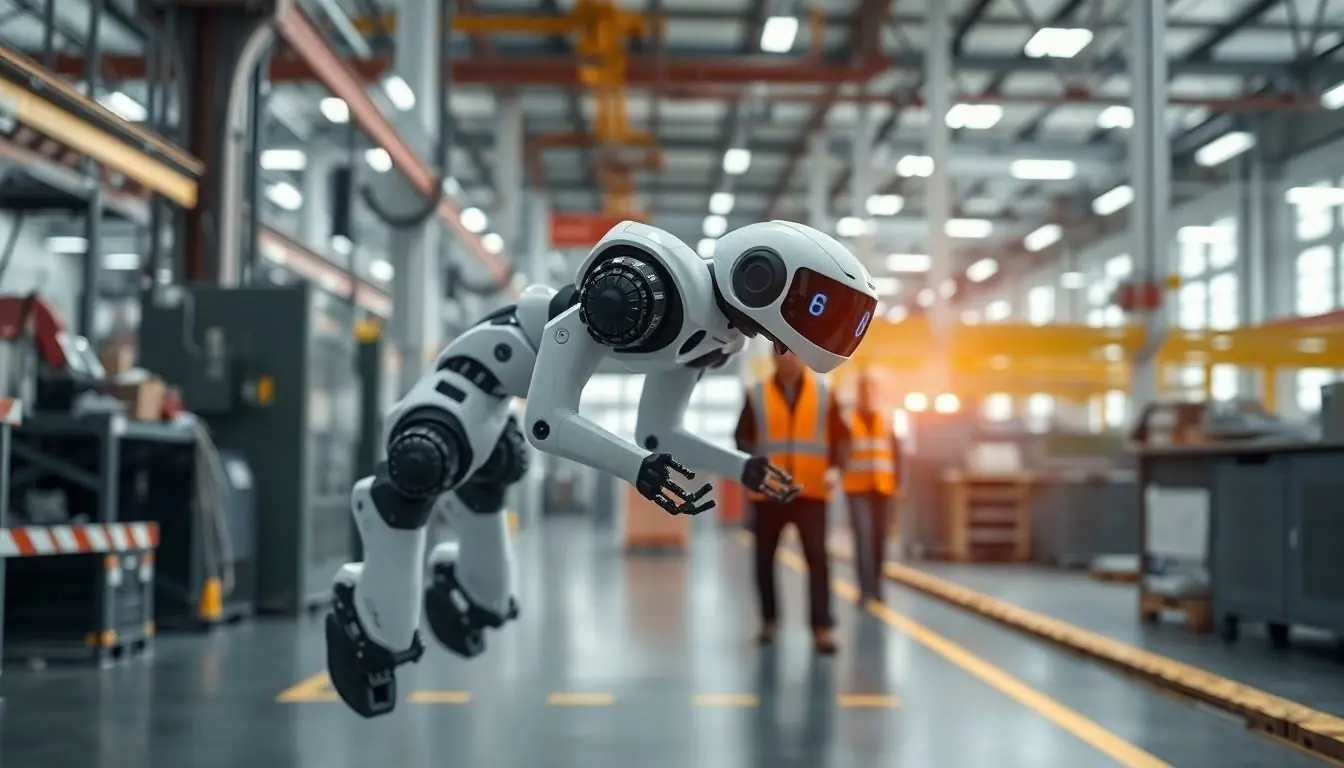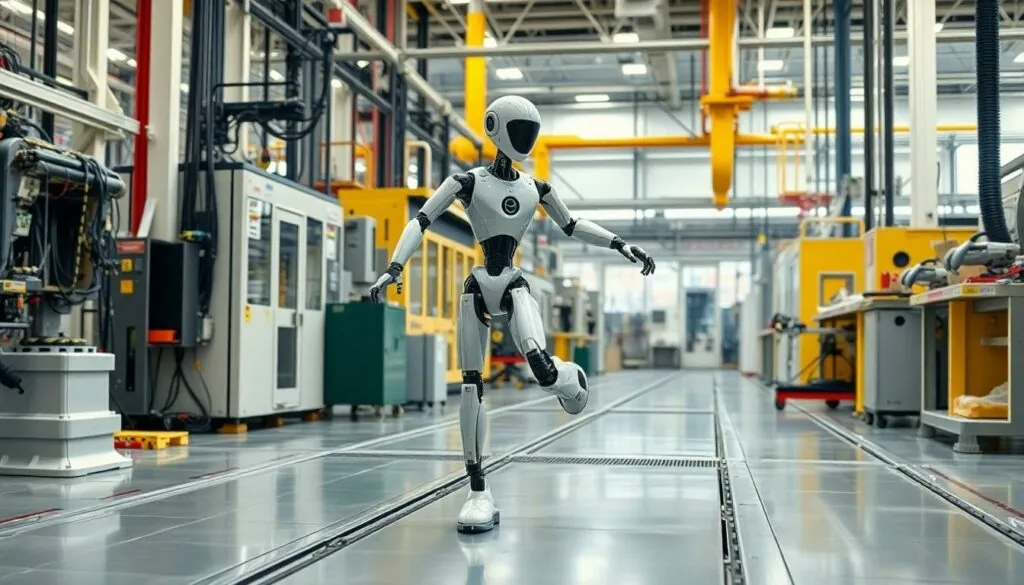Table of Contents
ToggleIn a world where robots are often portrayed as clunky metal beings with limited charm, reflex robotics is here to change the game. Imagine a robot that not only reacts faster than a cat on a hot tin roof but also adapts to its environment with the grace of a ballet dancer. This isn’t just science fiction; it’s the cutting-edge evolution of robotics that’s making waves across industries.
Overview of Reflex Robotics
Reflex robotics represents a significant shift in robotic technology, emphasizing speed and agility. These robots demonstrate rapid responsiveness, swiftly adapting to their environments. In various industries, such as manufacturing, healthcare, and entertainment, flexibility plays a crucial role in improving efficiency and safety.
Advanced sensors and algorithms underpin reflex robotics, enabling them to process information in real-time. Machines equipped with artificial intelligence enhance decision-making and reaction times, leading to seamless interactions with their surroundings. Companies investing in reflex robotics often report increased productivity levels, showcasing tangible benefits from these innovations.
The design of reflex robots typically incorporates lightweight materials, allowing for fluid movements akin to those of athletes. They can maneuver through tight spaces and navigate complex terrains with ease. This adaptability positions reflex robotics as ideal solutions for challenging tasks in dynamic environments.
Reflex robotics also prioritizes human-robot collaboration. Many systems are designed to work alongside human operators, improving workflows and task execution. These robots can take on repetitive or hazardous tasks, allowing employees to focus on more strategic responsibilities.
As industries continue to adopt reflex robotics, the implications for future technology are significant. It fosters an environment where efficiency and safety coexist, paving the way for more sophisticated robotic solutions. Energy efficiency in these robots further enhances their appeal, integrating sustainability into their operational designs.
Key Features of Reflex Robotics

Reflex robotics showcases innovative features that enhance their functionality and usability across various industries.
Adaptability to Different Environments
Flexibility characterizes reflex robots, enabling them to function effectively in diverse settings. These robots can operate in dynamic environments, such as factories, hospitals, and outdoor areas. They respond swiftly to changes in surroundings, showcasing impressive maneuverability and spatial awareness. Lightweight materials contribute to their agility, allowing them to navigate complex terrains with ease. This adaptability makes reflex robots suitable for a range of applications, from assembly lines to assisting healthcare professionals in tight spaces.
Real-Time Decision Making
Speed of decision-making distinguishes reflex robotics from traditional robotic systems. Equipped with advanced sensors and algorithms, these robots process real-time information efficiently. Data analysis occurs without delay, enabling prompt reactions to environmental changes. Artificial intelligence enhances this capability further, leading to improved interaction between robots and their surroundings. Timely decision-making increases operational efficiency, allowing reflex robots to optimize workflows across various sectors. By integrating smart technology, these robots significantly elevate workplace productivity and safety.
Applications of Reflex Robotics
Reflex robotics finds applications across various sectors, improving efficiency and enhancing safety. Two primary areas benefiting from these advancements are healthcare and manufacturing.
Healthcare
In healthcare, reflex robotics plays a crucial role in enhancing patient care. Surgical robots assist surgeons with precision, allowing for minimally invasive procedures and faster recovery times. Rehabilitation robots support patients in regaining mobility, offering tailored exercises and real-time feedback. Additionally, these robots streamline hospital logistics, efficiently transporting supplies and medications. They navigate complex hospital environments, reducing the burden on staff and ensuring timely patient services. With the ability to adapt to changing conditions, reflex robotics enhances overall patient outcomes and operational efficiency.
Manufacturing
Manufacturing benefits significantly from reflex robotics through increased productivity and safety. These robots excel in assembly lines, performing tasks quickly and accurately while adapting to different production requirements. They handle repetitive tasks, freeing human workers for more strategic roles. Reflex robotics allows for real-time monitoring and adjustments, resulting in fewer errors and reduced downtime. Robots equipped with advanced sensors navigate complex factory layouts, promoting safer work environments. This agility translates into seamless integration with human teams, fostering collaboration that improves workflow and job satisfaction.
Benefits of Reflex Robotics
Reflex robotics offers several key advantages that transform various industries. These benefits include increased efficiency and enhanced safety.
Increased Efficiency
Reflex robotics significantly improves operational efficiency across multiple sectors. Fast responsiveness enables these robots to execute tasks rapidly, reducing production time. Advanced algorithms process data in real-time, allowing for quick adjustments to workflows. For instance, in manufacturing settings, reflex robots complete repetitive tasks at higher speeds, leading to greater output. Companies integrating these technologies often witness productivity gains upwards of 30%. Many facilities adopt reflex robotics to streamline processes, ultimately boosting overall performance.
Enhanced Safety
Enhanced safety represents another vital benefit of reflex robotics. The ability to adapt swiftly to environmental changes minimizes the risk of accidents. In high-risk industries, these robots can perform dangerous tasks, shielding human workers from potential hazards. For example, reflex robots are often deployed in manufacturing environments to carry heavy loads, reducing the chance of injury. Real-time monitoring capabilities allow for immediate detection of anomalies, further promoting a safer workspace. Organizations implementing reflex robotics frequently report lower incident rates, creating a culture of safety and collaboration.
Challenges and Limitations
Reflex robotics faces several challenges that could impact their widespread adoption. High initial costs often deter companies from investing in these advanced technologies. Many organizations recognize the long-term benefits, yet the upfront expense can be prohibitive.
Another issue pertains to technological integration. Combining reflex robotics with existing systems requires seamless compatibility, which may not always be achievable. Potential challenges in system interoperability can complicate implementation strategies.
Reliability also poses a concern. Environmental conditions can affect sensor performance, impacting a robot’s ability to respond accurately. In unpredictable environments, such as construction sites or disaster zones, maintaining consistent functionality becomes critical.
Moreover, safety protocols necessitate thorough evaluation. As reflex robots are designed to work alongside humans, establishing clear safety standards is essential. Rigorous testing and certification processes help to ensure they can operate without posing risks to human co-workers.
Skill gaps in the workforce further complicate deployment. Few employees possess the necessary training to operate and maintain these advanced robotic systems. Companies may face hurdles in providing adequate education and resources to their staff.
Lastly, regulatory issues can create obstacles. Compliance with industry regulations is crucial in sectors like healthcare or manufacturing. Adapting to rapidly changing regulatory environments may require ongoing adjustments to robotic systems, straining resources and timelines.
Addressing these challenges necessitates a balanced approach that considers costs, integration, and safety standards. Organizations that successfully navigate these hurdles can realize the numerous advantages that reflex robotics offers across various sectors.
Future Trends in Reflex Robotics
Technological advancements in reflex robotics continue to evolve rapidly, impacting various industries. Enhanced artificial intelligence algorithms improve the decision-making capabilities of these robots, fostering smoother interactions in dynamic environments. Adaptable reflex robots will likely lead to greater efficiency and safety in areas such as healthcare and manufacturing.
In healthcare, the integration of reflex robotics is set to revolutionize patient care. Surgeons benefit from precision assistance during procedures, allowing for better outcomes and improved recovery times. Expect increased use in hospital logistics, where robots efficiently manage inventory and streamline workflows.
Manufacturing processes will also undergo transformation thanks to reflex robotics. Automation in assembly lines enhances productivity and minimizes error rates. As companies adopt these technologies, they witness a noticeable rise in operational efficiency, with reported gains often exceeding 30 percent.
Sustainability becomes a priority in reflex robotics design. Lightweight materials not only improve agility but also contribute to energy efficiency. Resulting innovations in renewable energy sources will enhance the appeal of these robots in eco-conscious markets.
Future trends indicate a stronger emphasis on collaborative human-robot work environments. Reflex robots will increasingly serve alongside human workers, taking on repetitive or dangerous tasks. This mutual collaboration fosters productivity while enhancing worker safety.
Addressing current challenges remains essential as reflex robotics advances. High initial costs and integration complexities require careful planning for effective implementation. Organizations must develop comprehensive training programs to bridge workforce skill gaps and ensure safety protocols remain a top priority.
Reflex robotics is reshaping the landscape of automation with its unique blend of speed and agility. As industries increasingly adopt these advanced systems, the benefits of enhanced efficiency and safety become evident. The ability to navigate complex environments and collaborate with human workers sets reflex robots apart from traditional automation solutions.
While challenges like high initial costs and integration hurdles remain, the potential for significant productivity gains and improved workplace safety makes reflex robotics an attractive investment. The future promises even greater advancements, with ongoing innovations likely to further enhance their capabilities. Embracing reflex robotics could be the key to unlocking new levels of operational excellence across various sectors.




